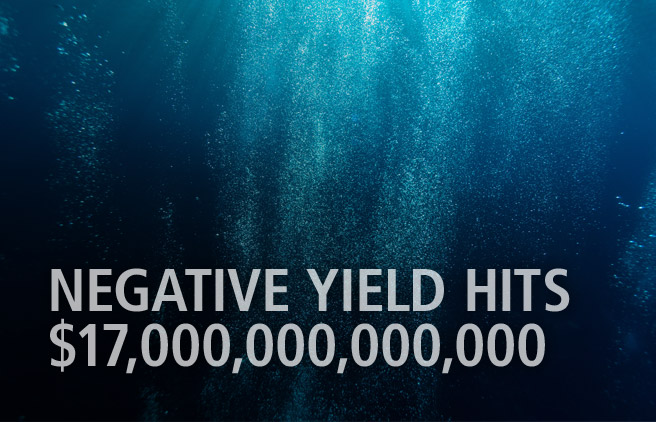
Negative-yielding debt reaches $17 trillion
Negative bond yields occur when issuers of debt are paid to borrow. This unusual situation has taken financial markets by storm as negative-yielding debt recently reached an unprecedented $17,000,000,000,000 globally.
What drives negative yields?
The Bank of Japan and the European Central Bank have set interest rates below zero for quite some time. At the time of writing, the Bank of Japan’s interest rate is –0.1% and the European Central Bank’s deposit rate is -0.5%. As global economies slow due to trade tensions, central banks globally have vowed to cut interest rates. It is widely expected that interest rates will fall to zero or close to zero in all major economies, including the U.S. In Japan and Europe, rates may fall further from already negative levels. Bond yields are effectively the average of future interest rates.
Bond prices have been bid up through quantitative easing, an unconventional policy in which central banks purchase bonds in the market to increase money supply and encourage lending. The price of a bond and its yield are inversely related. This means higher the price, the lower the interest rate offered.
What are the implications?
Due to low and negative interest rates, bonds with positive yields are in high demand. This helps to explain the recent rally in North American bond markets.
U.S.
1.55%
Japan
-0.24%
Canada
1.29%
Belgium
-0.29%
New Zealand
1.18%
France
-0.34%
Australia
1.07%
Finland
-0.36%
Italy
0.88%
Austria
-0.37%
U.K.
0.50%
Netherlands
-0.50%
Denmark
-0.61%
Germany
-0.64%
Switzerland
-0.92%
Source: Bloomberg L.P., as at September 6, 2019.
Investors who purchase negative yielding bonds and hold them to maturity are guaranteed a loss. However, if yields fall further from the existing negative levels, these investors could potentially earn a capital gain before maturity. For this reason, we are actively managing our bond positions as their prices fluctuate. For example, we have some exposure to Japanese bonds as we expect yields to continue to fall.
Negative yields encourage more borrowing as it becomes easier to break even. The majority of bonds with negative yields are government bonds. Since governments hold the power to tax their citizens and to print money, the risk of default is very low. Bonds issued by businesses and individuals generally have higher yields. The difference in these yields compared to government bond yields is known as the “risk premium.” The risk premium compensates investors for the higher risk of default and varies based on creditworthiness. As government borrowing rates fall, borrowing rates for businesses and individuals also fall. Most businesses are borrowing at a range between -0.5% to 3% on a five-year term. The good news is that an investment needs very little return to cover the interest expense.
In summary, while negative yielding bonds are unusual, they are not surprising as central banks continue to implement unprecedented polices. We believe the implications could lead to investment opportunities.
 By Alfred Lam, CFA, Senior Vice-President and Chief Investment Officer and Marchello Holditch, CFA, Vice-President and Portfolio Manager CI Multi-Asset Management
By Alfred Lam, CFA, Senior Vice-President and Chief Investment Officer and Marchello Holditch, CFA, Vice-President and Portfolio Manager CI Multi-Asset Management
This document is intended solely for information purposes. It is not a sales prospectus, nor should it be construed as an offer or an invitation to take part in an offer. This report may contain forward-looking statements about one or more funds, future performance, strategies or prospects, and possible future fund action. These statements reflect the portfolio managers’ current beliefs and are based on information currently available to them. Forward-looking statements are not guarantees of future performance. We caution you not to place undue reliance on these statements as a number of factors could cause actual events or results to differ materially from those expressed in any forward-looking statement, including economic, political and market changes and other developments. United pools are managed by CI Investments Inc. Assante Wealth Management is a subsidiary of CI Investments Inc. Neither CI Investments Inc. nor its affiliates or their respective officers, directors, employees or advisors are responsible in any way for damages or losses of any kind whatsoever in respect of the use of this report. Commissions, trailing commissions, management fees and expenses may all be associated with investments in mutual funds and the use of the Asset Management Service. Any performance data shown assumes reinvestment of all distributions or dividends and does not take into account sales, redemption or optional charges or income taxes payable by any securityholder that would have reduced returns. Mutual funds are not guaranteed, their values change frequently and past performance may not be repeated. Please read the fund prospectus and consult your advisor before investing. Assante Wealth Management and the Assante Wealth Management design are trademarks of CI Investments Inc. CI Multi-Asset Management is a division of CI Investments Inc. This report may not be reproduced, in whole or in part, in any manner whatsoever, without prior written permission of Assante Wealth Management. Copyright © 2019 Assante Wealth Management (Canada) Ltd. All rights reserved.
Negative bond yields occur when issuers of debt are paid to borrow. This unusual situation has taken financial markets by storm as negative-yielding debt recently reached an unprecedented $17,000,000,000,000 globally.
What drives negative yields?
The Bank of Japan and the European Central Bank have set interest rates below zero for quite some time. At the time of writing, the Bank of Japan’s interest rate is –0.1% and the European Central Bank’s deposit rate is -0.5%. As global economies slow due to trade tensions, central banks globally have vowed to cut interest rates. It is widely expected that interest rates will fall to zero or close to zero in all major economies, including the U.S. In Japan and Europe, rates may fall further from already negative levels. Bond yields are effectively the average of future interest rates.
Bond prices have been bid up through quantitative easing, an unconventional policy in which central banks purchase bonds in the market to increase money supply and encourage lending. The price of a bond and its yield are inversely related. This means higher the price, the lower the interest rate offered.
What are the implications?
Due to low and negative interest rates, bonds with positive yields are in high demand. This helps to explain the recent rally in North American bond markets.
| U.S. | 1.55% | Japan | -0.24% |
| Canada | 1.29% | Belgium | -0.29% |
| New Zealand | 1.18% | France | -0.34% |
| Australia | 1.07% | Finland | -0.36% |
| Italy | 0.88% | Austria | -0.37% |
| U.K. | 0.50% | Netherlands | -0.50% |
| Denmark | -0.61% | ||
| Germany | -0.64% | ||
| Switzerland | -0.92% |
Source: Bloomberg L.P., as at September 6, 2019.
Investors who purchase negative yielding bonds and hold them to maturity are guaranteed a loss. However, if yields fall further from the existing negative levels, these investors could potentially earn a capital gain before maturity. For this reason, we are actively managing our bond positions as their prices fluctuate. For example, we have some exposure to Japanese bonds as we expect yields to continue to fall.
Negative yields encourage more borrowing as it becomes easier to break even. The majority of bonds with negative yields are government bonds. Since governments hold the power to tax their citizens and to print money, the risk of default is very low. Bonds issued by businesses and individuals generally have higher yields. The difference in these yields compared to government bond yields is known as the “risk premium.” The risk premium compensates investors for the higher risk of default and varies based on creditworthiness. As government borrowing rates fall, borrowing rates for businesses and individuals also fall. Most businesses are borrowing at a range between -0.5% to 3% on a five-year term. The good news is that an investment needs very little return to cover the interest expense.
In summary, while negative yielding bonds are unusual, they are not surprising as central banks continue to implement unprecedented polices. We believe the implications could lead to investment opportunities.
 By Alfred Lam, CFA, Senior Vice-President and Chief Investment Officer and Marchello Holditch, CFA, Vice-President and Portfolio Manager CI Multi-Asset Management
By Alfred Lam, CFA, Senior Vice-President and Chief Investment Officer and Marchello Holditch, CFA, Vice-President and Portfolio Manager CI Multi-Asset Management
This document is intended solely for information purposes. It is not a sales prospectus, nor should it be construed as an offer or an invitation to take part in an offer. This report may contain forward-looking statements about one or more funds, future performance, strategies or prospects, and possible future fund action. These statements reflect the portfolio managers’ current beliefs and are based on information currently available to them. Forward-looking statements are not guarantees of future performance. We caution you not to place undue reliance on these statements as a number of factors could cause actual events or results to differ materially from those expressed in any forward-looking statement, including economic, political and market changes and other developments. United pools are managed by CI Investments Inc. Assante Wealth Management is a subsidiary of CI Investments Inc. Neither CI Investments Inc. nor its affiliates or their respective officers, directors, employees or advisors are responsible in any way for damages or losses of any kind whatsoever in respect of the use of this report. Commissions, trailing commissions, management fees and expenses may all be associated with investments in mutual funds and the use of the Asset Management Service. Any performance data shown assumes reinvestment of all distributions or dividends and does not take into account sales, redemption or optional charges or income taxes payable by any securityholder that would have reduced returns. Mutual funds are not guaranteed, their values change frequently and past performance may not be repeated. Please read the fund prospectus and consult your advisor before investing. Assante Wealth Management and the Assante Wealth Management design are trademarks of CI Investments Inc. CI Multi-Asset Management is a division of CI Investments Inc. This report may not be reproduced, in whole or in part, in any manner whatsoever, without prior written permission of Assante Wealth Management. Copyright © 2019 Assante Wealth Management (Canada) Ltd. All rights reserved.





